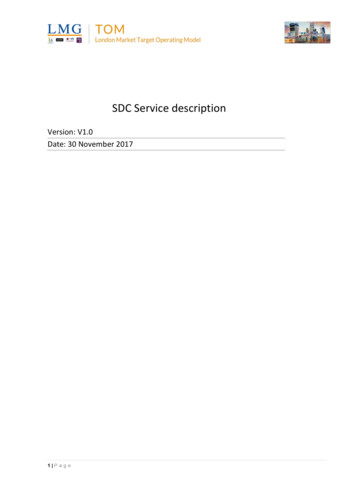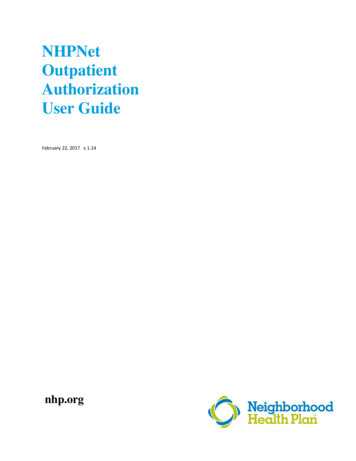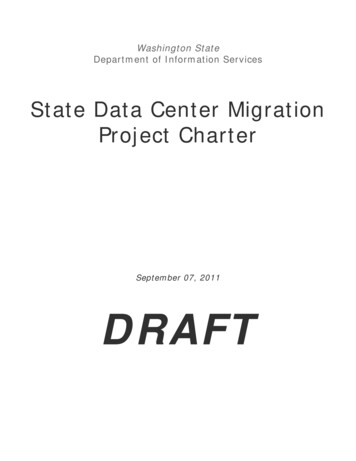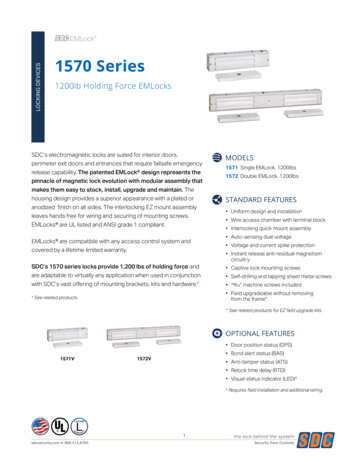
Transcription
SDC Service descriptionVersion: V1.0Date: 30 November 20171 P a g e
Sign-offVersionDateAuthoriserRole / Position/OrganisationPeter BloxamEAOscar PatrickProgramme LeadStuart McPheeProgramme DirectorAuthoriserRole / Position/OrganisationPeter BloxamEAOscar PatrickProgramme LeadStuart McPheeProgramme DirectorDistribution ListVersion2 P a g eDate
Contents1Background42Structured Data Capture Limited (SDCL) Structure43Service Description3.1 SDC High Level Overview3.2 Document Types in Scope3.2.1 Document Types3.3 Simplified end-to-end Service Map555564Service Management4.1 RACI Matrix4.2 Web Connectivity4.2.1 Responsibilities4.2.2 Service Levels4.2.3 Service Request Interactions4.2.4 Web Connectivity Agreement4.3 DDC (Processor)4.3.1 Responsibilities4.3.2 Service Levels4.3.3 DDC Agreement4.4 SDCL (Support)4.4.1 Responsibilities4.4.2 Service Levels4.4.3 SDCL (Support) Agreement7777889991010101010105Management Information5.1 Internal Management Information5.2 External Management Information1010116Appendix – Service Management Processes121Incident Management1.1 Definition of an Incident1.2 Goal of Incident Management1.3 Process Activities1.4 Incident Management Responsibilities of Each Team1.4.1 Service Desk1.4.2 SDCL (Support Team)1.4.3 DDC Support Team12121212131313133 P a g e
1 BackgroundThis document provides a summary of Structured Data Capture Limited (SDCL), the SDC Service and how its componentparts are supported by individual detailed service agreements. The purpose of this document is to provide an orientationto someone who requires a quick high- to mid-level understanding of the service that can be deepened upon review of themore detailed service agreements cited within this document.2 Structured Data Capture Limited (SDCL) Structure2.1 SDCL Supplier Role SummarySupplierRoles and ResponsibilitiesKofaxAutomatic OCR Extraction SoftwareDDC (BPO)Operator Quality ControlWeb ConnectivityCentral Service Desk, Infrastructure Support, ReportingGrant ThorntonAccountancy, Invoicing, BillingImagefastDevelopment resource4 P a g e
3 Service DescriptionThe SDC Service provides an SDC Customer with an automated solution that extracts data from SDC Documents andconverts the data into an XML output (aligned to ACORD standards) for use within the SDC Customer’s business operations.The service will be described in greater detail in the Service Description below, particularly in relation to the first documenttype that will be processed, the MRC.SDC Documents submitted to the SDC Service are processed by software using automated extraction rules developed forthe SDC Service which maps the content based on defined fields within the applicable Document Type. The raw output isreviewed and, if required, corrected in accordance with agreed manual processing rules by the BPO Subcontractor (DDC).The resulting output is then provided to the SDC Customer in an XML file conforming to ACORD standards.The SDC Service is supported by a Service Desk that is managed by Web Connectivity, who will also take ownership of MIproduction. Web Connectivity is also responsible for the management, maintenance and servicing of the AZUREinfrastructure and environments that the SDC Service resides on, as well as BAU software stability.3.1 SDC High Level Overview3.2 Document Types in ScopeThe Document Types that are in-scope for the SDC Service will vary over time. The table in section 2.1.1 indicates theDocument type that are already in Scope or due to come into scope;3.2.1 Document TypesDocument TypeSingle-section firm order MRCsMulti-section firm order MRCsIn Production3/7/17 for Terrorism, Marine, Property, FinancialProducts and Casualty; H2 2017 date TBD for otherclasses of businessthPhase 1 - 24 multi sections MRC fields live 10 Nov 17SchedulesOut of ScopeQuotesRelease 4 June 2018EndorsementsRelease 5 June20185 P a g e
Delegated Authority Binding Authority contracts –Line SlipsRelease June 2018Release 4 June 2018Master AgreementsRelease 5 July 2018Reduced ValidationRelease 4 April 20183.3 Simplified end-to-end Service MapSubmitIn submit, the SDC Customer submits in-scope documents in in-scope formats (PDF, Word or Tiff) to SDC for data extractionto be performed. Documents are submitted via the customer’s preferred submission method: SDC Portal PPL E-mail TMEL Message GatewayReviewDocuments of the appropriate format have first stage OCR performed upon them. Any documents not passing this stageand progressing directly to the next stage are presented to operators for review and remediation, if possible. Out-of-scopedocuments and documents of poor quality (too light/dark, pages missing, etc.) that can’t be remediated are rejected withan explanation.RoutingDocuments are routed to operators who will provide any required manual intervention. Routing utilises rules set by DDCthat match document type to the skill and experience level of the receiving operators. The likely percentage of fields thatwill be extracted accurately without the requirement for manual intervention is currently estimated between 80-90%,meaning that there is always a likely requirement for operator review.6 P a g e
ValidationAll data fields that couldn’t be extracted with confidence are presented to operators for their review. Operators reviewand either accept or amend information that is presented in fields that didn’t meet the defined extraction confidencelevels. In the case of blank fields, the operators either find the data within the document that OCR was not able to extractwith confidence or they confirm that no information was presented in the original document.VerificationA selected percentage of documents will be presented to experienced operators or supervisors to perform qualityassurance on a percentage of fields in the document. The percentages will vary depending upon various factors, includingthe maturity of the service, the newness of document type, the experience level of an operator and even the carrier orbroker. Corrections are made where appropriate and findings are used to mitigate future errors.Return and ReceiveOnce processing is completed on a document, the extracted output is returned to the SDC Customer via email and alsoavailable via the SDC Portal. Unless the SDC Customer has, a challenge regarding the accuracy of the output (coveredbelow), the SDC process ends here and the customer reviews, amends and uses the data as required.Accuracy ChallengeIf a customer believes that the data was not extracted accurately or that the output should be fundamentally different (e.g.the extraction rules should be changed) they can raise a Accuracy challenge via the Service Desk that will be progressed ina controlled, time-bound manner to a conclusion.4 Service ManagementThe RACI of each party involved in supporting the SDC service are outlined below. Each teams Service agreement isattached; these documents detail the activities each are responsible for and the associated Service Levels.There is also an overarching OLA (Operational Level Agreement) in place between the supporting Suppliers. The purpose ofthis agreement is to ensure that all parties that contribute to the overall delivery of this service are aware of theirresponsibilities and to ensure service level targets are met. The OLA is located within the LIMOSS Portal here.4.1 RACI MatrixThe RACI below is for supporting the SDC service; the workflow within the Incident Management process below providesmore detail on the activities each team complete within the Incident process.R Responsible, A Accountable, C Consulted, I InformedIncidentEscalation-Escalation –Change/ ReleasesManagementSoftwareProcessingto SDC ServiceLifecycleDocument ErrorsDocument ErrorsWeb ConARRADDCRCACSDCLRAIRSDC CustomerIICI4.2 Web ConnectivityWeb Connectivity shall provide the SDC Services and deliver the Deliverables to the SDC Customer in accordance with theirAgreement including its Schedules and shall allocate sufficient resources to the SDC Services to enable it to comply with thisobligation.4.2.1 ResponsibilitiesWeb Connectivity provides the SDC Customer a Service Desk which is a single point of contact to raise Incidents andRequests. The Service Desk Operating Hours are between 08:00 to 18:00 on Business Days It is Web Connectivity’sresponsibility for the ownership of all tickets through to resolution that relate to the SDC Services, in accordance with the7 P a g e
Service Levels (see below), including, where necessary, by coordinating with Third Parties to Resolve an Incident. WebConnectivity responsibility also includes the distribution of monthly SDC Customer reports, which is further detailed in theManagement Information section below.4.2.2 Service LevelsThe table below sets out the target Service Levels, which Web Connectivity shall use all reasonable endeavours to achievewhen delivering the relevant ateFrequencyTimesResolutionTimes1 (Critical)Any Incident that has caused a complete loss of the SDCService or a degradation of service to the point thatmultiple SDC Customers are unable to use the SDC Serviceto perform business operations.30 MinutesEvery 30Minutes4OperatingHours1 OperatingHourEveryOperatingHour8OperatingHours4 OperatingHoursEvery 4OperatingHours3 BusinessDays4 OperatingHoursEvery BusinessDay5 BusinessDays2 (High)An Incident has caused a complete loss of the SDC Serviceor a degradation of service to the point that a single SDCCustomer is unable to use the SDC Service to performbusiness operations.ORAn Incident has caused a Severe Degradation of the SDCService to the point which adversely impacts the ability ofone or more SDC Customer’s to use the SDC Service toperform business operations.For purposes hereof, a "Severe Degradation" means thatthe SDC Customer is able to use one or more, but not all ofthe functionality/features of the SDC Service as intended.For example, the SDC Customer is unable to submit SDCDocuments for processing by a normal channel.An Incident has resulted in a Minor Degradation of theSDC Service.3 (Medium)For purposes hereof, a "Minor Degradation" means thatthe SDC Customer is able to use all of thefunctionality/features of the SDC Service, but one more ofthe functions/features is operating sub-optimally. Forexample, the SDC Customer experiences unusually longresponse times upon executing standard requests via theSDC Portal.An Incident has not resulted in any degradation of the SDCService but has resulted in an Inconvenience to anIndividual User.4 (Low)For purposes hereof, a "Inconvenience" means that theSDC Customer is able to use all of thefunctionality/features of the SDC Service, but mayexperience abnormal behaviour. For example, SDCCustomer notices Portal look and feel has changed slightlyor is receiving incorrect error messages.4.2.3 Service Request Interactions8 P a g e
Below is a list of requests and the interactions between the Service Desk, SDCL, SDC Customer and Processor and thePriority levels associated with each type of request.ActionRequesterPriorityJoiners / MoversSDC Customer Admin / Processor / SDCLP3LeaversSDC Customer Admin / Processor / SDCLP2Locked Server SessionProcessor / SDCLP3Kofax Session LockedProcessor / SDCLP3Login FailureSDC Customer Admin / Processor / SDCLP2SDC Accuracy ChallengeSDC CustomerP3Configuration Changes / GW /KofaxSDCLP4Start / Stop Server Services (standardSDCLP3Back-up Restore (standard CR)SDCLP4Emergency Change RequestsSDCLP2Firewall Changes (standard CR)SDCLP4Replay of dataSDCLP3CR)4.2.4 Web Connectivity AgreementCOPY OF WCL AGREEMENT TO BE INSERTED ONCE SIGNED BY ALL PARTIES.4.3 DDC (Processor)The service that DDC deliver within the SDC Service is detailed within the DDC Service Agreement attached. DDC isresponsible from the submission of SDC Documents by SDC Customers to the return of the extracted output, including anythe resolution of any challenge of output Accuracy that an SDC Customer may choose to make.4.3.1 ResponsibilitiesDDC accesses the Kofax software remotely, which Web Connectivity will host outside of DDC’s infrastructure environment.While DDC is not responsible for the performance of the Software or the infrastructure, DDC is required to raise timelysupport requests to the Service Desk immediately upon becoming aware of any incidents that may or will impact DDC’sability to provide the SDC Service in accordance with the Service Levels in section 3.2.2.DDC’s activities to support each process step will be specified. For completeness, even those process steps in which DDChas no direct activity will be documented, e.g. Submit, in which SDC Customers send SDC Documents into the SDC Service.In Submit, the SDC Customer submits the SDC Documents to DDC for data extraction to be performed. There is automatedreview of whether the SDC Documents are in the appropriate format and then in-scope. If there are any issues, the SDCCustomer is sent an automated rejection notice. DDC is not involved in this process step;SDC Documents that are not rejected are presented to DDC operators through the SDC system.9 P a g e
4.3.2 Service LevelsThe key service measurements are end-to-end turn-around time (start: receipt from customer; finish: return to thecustomer) and the accuracy of the extracted data as detailed below: Turn-around time: same day (all documents received between 0800-1400 to be returned by 1800 on day ofreceipt; all documents received between 1400-1800 to be returned by 0800 the following day) Data accuracy: 98% of all fields are extracted accurately on a like-for-like basis4.3.3 DDC AgreementThe DDC Agreement can be located here within the LIMOSS SharePoint Portal.4.4 SDCL (Support) Within SDCL there is an SDC support team which support the SDC software, they log all document errors that aresoftware related providing feedback to the Service Desk when necessary.Software fixes/patches are maintained in a backlog list which may be considered to be incorporated into futurereleases.rdThe own the relationship between SDC and Kofax the 3 party software provider4.4.1 ResponsibilitiesThe team are responsible for raising software related Change Requests and associated Releases to maximize efficiencyof the SDC service. They are also responsible for logging and managing support tickets with Kofax for level 2 and level 3support on behalf of the Service Desk and SDC Customer.4.4.2 Service LevelsThe Service Levels the SDC team adhere to are aligned to the agreed Service Levels with Web Connectivity stated insection 3.2.2.4.4.3 SDCL (Support) AgreementCOPY OF MUA TO BE INSERTED ONCE FINAL COPY ISSUED.5 Management Information5.1 Internal Management InformationComprehensive management information underpins the process, providing required information for allSuppliers, Chanel Suppliers and SDCL: DDC – operational control and service deliverySDC Customers – volumes and SLA performanceSDCL – information required for billing as well as full process oversight from high-level overviews todetailed performance data to support improvement effortsWCL – Service Desk Incident and Request MetricsKey Performance Indicators (KPI) and metrics defined in each process will detail the performance of the SDCservice holistically whilst quantifying and identifying areas for improvement.These measures will include volumes received, outcomes (rejected, completed, and work in progress), cycletimes and accuracy rates for completed volumes, and OCR extraction rates.10 P a g e
There will be further Service Availability Key Performance Indicators that will be reviewed with WebConnectivity that will address any service interruptions and improvements. The reference table belowsummarises these measures:IndicatorService AvailabilityNumber of Service InterruptionsDuration of Service InterruptionsAvailability MonitoringDefinitionAvailability of IT Service relative to availability agreed in SLANumber of Service interruptionsAverage duration of service interruptionsPercentage of services and infrastructure components under availabilitymonitoring5.2 External Management InformationThe SDC Customer will receive Management Information reports on a monthly basis which will be madeavailable via email (to the SDC Customer Administrator, unless another email address is requested during theon-boarding process) in PDF form. These reports will contain executive summary of service performance forthe prior month, including performance with respect to the Processing Service Levels and SDC Customerspecific monthly SDC Documents volumes (submitted, completed, rejected, in process).11 P a g e
6 Appendix – Service Management Processes1 Incident Management1.1 Definition of an IncidentAny event which is not part of the standard operation of a service and which causes, or may cause, an interruption to, or areduction in, the quality of that service.1.2 Goal of Incident ManagementThe primary goal of the Incident Management process is to restore normal service operation as quickly as possible andminimise the adverse impact on business operations, thus ensuring that the best possible levels of service quality andavailability are maintained. ‘Normal Service’ is the service that is agreed within the Service Level Agreements.1.3 Process ActivitiesThe purpose of the incident management process is to introduce a consistent approach to call handling. This in turn willminimise downtime and impact to the Carrier as well as increasing the communication between the SDC Customer and SDCService ManagementSDC Incident Management ProcessEnd CarrierIncident ClassificationInvestigationResolution and onLink Incident toProblem RecordPre-ClosureActivitiesWeb ConService DeskYesOpen, Assign,Classify,PrioritiseMajorIncidentNoKnown wMajorIncidentProcessSoftwareDocumentIssuePerform InitialDiagnosisAdd KnownError to BacklogImplement Fix/WorkaroundFollowChangeProcess toimplementfixInvestigateextraction errorDDCTOM SDCSupportInvestigateYesNOYesCreate KnownErrorResolutionPrepared?Provide UpdateSDC Customer Logs Incident A SDC Customer will log an incident/ Request with the Service Desk.Service Desk Opens, Classifies and Prioritises Incident The Service Desk will update existing ticket or generate a new one, classifying and categorising the ticketappropriately.Assigning a priority in accordance with the agreementThe status must be updated to reflect the activity within the call12 P a g eIncident Closed
The Service Desk will ensure all the relevant information is captured in the notes of the incident. If this is notclear from the details sent through, the SDC Customer will be contacted for further information.Major Incident? Once the incident has been updated with the correct priority it can be determined if it is a Major IncidentTo be a major incident the call must be prioritised as Priority1 or Priority 2 meaning it must impact all Individualusers for a single or multiple SDC Customers and is critically urgent. If there is a major incident, The Service DeskMajor Incident process will be invoked which referenced within the attached WCL Agreement.Known Error? Can the incident be assigned to a Known Error? All known errors will be logged as problems in the Service DeskITSM tool.If an incident is logged is pertaining to a known error, the incident must be linked to the relevant problem record.Document Error? Is the error with the document a software error or a processing error?Once the Service Desk has determined what the error is, they will assign to the appropriate Resolver GroupSDCL (Support Team) – Software Document Error SDCL will investigate all software errors.Once they have determined if this is a bug, it will be added to the backlog list and resolved as part of a futurereleaseA known error will be created, and the information fed back to the Service DeskDDC Support- Processing Error If there is a processing error, the DDC team will investigate and feed back to the Service DeskInvestigation and Diagnosis For all other incidents and requests, the Service Desk will do further investigation and diagnosisIdentifying a resolution and liaising with the SDC CustomerResolution and Recovery Once a work around or permanent fix has been implemented and the SDC Customer has validated.The ticket can be closed.1.4 Incident Management Responsibilities of Each Team1.4.1 Service Desk The Single point of contact for SDC Customer, being the face and voice of the SDC serviceEnsure all tickets are classified and prioritised correctly.Owner off all tickets throughout their lifecyclerdLiaise with corresponding Suppliers and 3 Parties, providing updates to the SDC customer when necessary.Will deal with all SDC Customer complaints, escalating to the appropriate team when necessary1.4.2 SDCL (Support Team) SDCL support the SDC software, they log all document errors that are software related providing feedback to theService Desk when necessary.All Software bugs are maintained in a backlog list where resolutions be incorporated into future releases.Owns the relationship with Kofax for Level 2 and Level 3 support1.4.3 DDC Support Team They are responsible for investigating all processing errors providing feedback to the Service Desk whennecessary13 P a g e
14 P a g e
4.1 RACI Matrix The RACI below is for supporting the SDC service; the workflow within the Incident Management process below provides more detail on the activities each team complete within the Incident process. R Responsible, A Accountable, C Consulted, I Informed Incident Management Lifecycle Escalation- Software Document Errors










